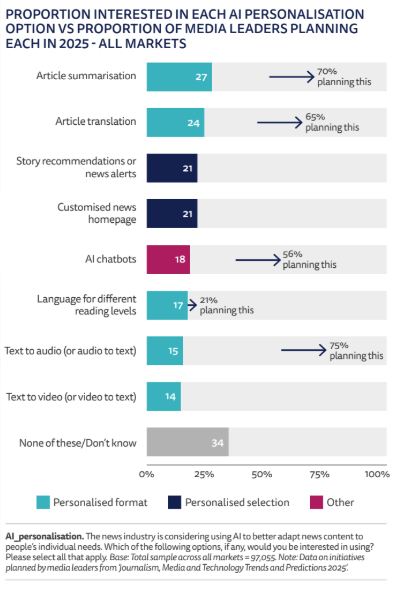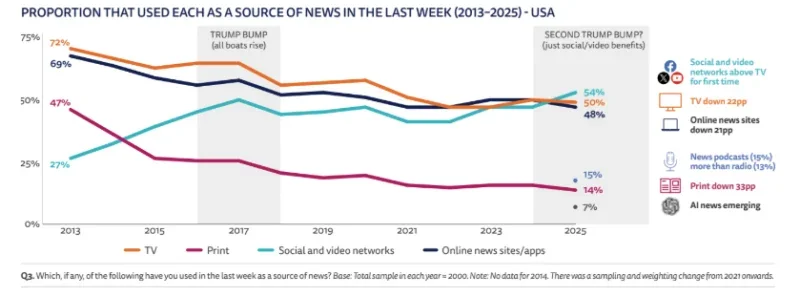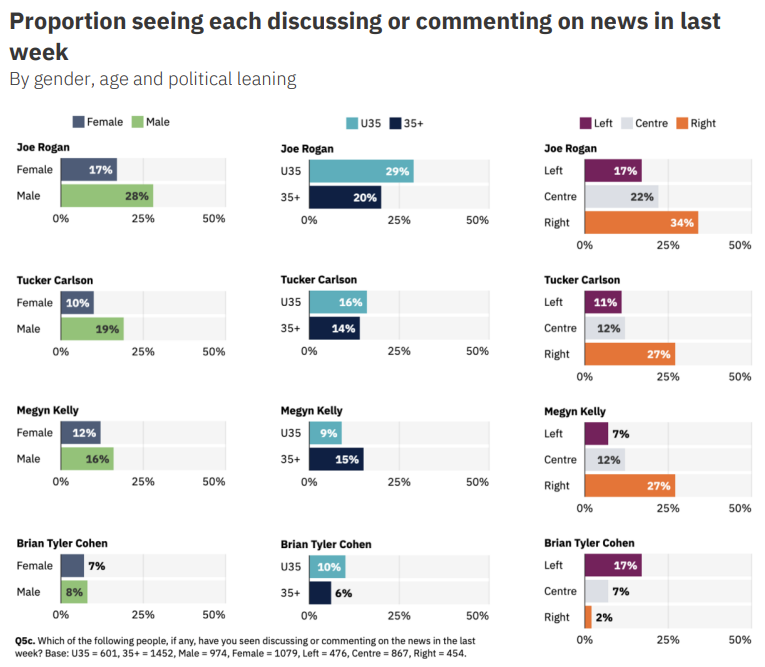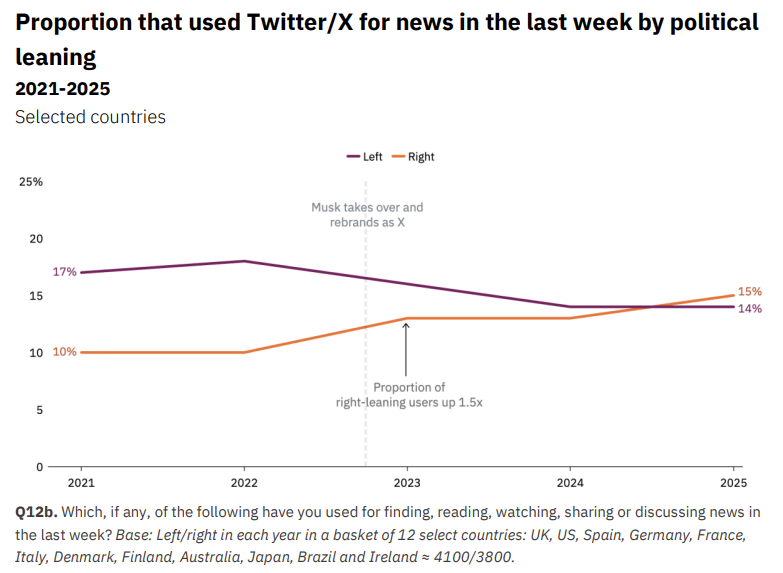
The use of AI chatbots for news is small but growing quickly, the latest annual Digital News Report looking at news trends for 2025 has found.
The report, from the Reuters Institute for the Study of Journalism, also highlighted the growing rise of an alternative media ecosystem led by Youtubers, Tiktokers and podcasters and the threat this poses to traditional news providers.
[Read more from Digital News Report launch event: Sky News chief on ‘halo-effect’ of personality-driven news]
In the US, social media platforms rose above TV as a source of news for the first time this year.
The evolving ways people access information sits against a backdrop in which trust in news has remained steady for the third year in a row (40% globally) although it is four percentage points lower than at the height of the Covid-19 pandemic.
In addition, avoidance of “the news” is the joint highest ever recorded by the Digital News Report, at 40% for the second year in a row – up from 29% in 2017. In the UK, 46% of people said they sometimes or often avoid the news while it was 42% in the US.
About four in ten (39%) of “news avoiders” say the news has a negative effect on their mood, while 31% said they are worn out by the amount of it, 30% say there is particularly too much war and conflict coverage and 29% are fed up with politics news.
Also: lead report author Nic Newman has written for us about what the data says about mobile push alerts and how the audience feels about them.
AI chatbots reported as news source for first time
The Reuters Institute asked about usage of AI platforms and chatbots for news for the first time in the 2025 survey.
Some 7% of respondents globally said they had used an AI chatbot as a source of news in the previous week, rising to 15% among under-25s and 12% among under-35s.
ChatGPT was the most-used chatbot for news (4% among the whole sample), followed by Google Gemini including AI Overviews in search (2%) and Meta AI (2%). Claude, Perplexity, Snapchat AI and Microsoft Copilot were all on 1%. The report suggested the low score for Google’s AI Overviews may be due to low audience awareness of the AI involvement in what they see in search.
The UK saw low usage of AI chatbots for news (3%) and also had one of the lowest comfort levels (11%) when asked how they felt about news being made mostly with AI with some human oversight. This compares to India at the other end of the spectrum where 18% of the sample said they were using chatbots for news and 44% were comfortable with AI in this way.
In the US, 1% of 18 to 24-year-olds and 25 to 34-year-olds said AI chatbots were their main source of news, with 0% saying so among older audiences.
For under 25s this is only just behind printed news sources (2%, down four percentage points in a year) and news podcasts (3%).
But asked where they would look when they want to check information they think might be false, AI chatbots were lower (9%) than social media (14%) and other sources. Some 38% said they would go to a news source they trusted.
However younger groups were “proportionately more likely than other groups to check social media, including by reading comments from other users to help them make up their minds, as well as using AI chatbots. This highlights how younger groups have developed a ‘flatter’ pattern of trust in media than older generations, gathering information without a shared sense of a ‘hierarchy of validation’.”
The report said: “As the largest tech platforms integrate AI summaries and other news-related features, publishers worry that these could further reduce traffic flows to websites and apps.
“But we also show that in a world increasingly populated by synthetic content and misinformation, all generations still prize trusted brands with a track record for accuracy, even if they don’t use them as often as they once did.”
How audiences respond to news personalisation using AI
About half (49%) of consumers are comfortable with the idea of using websites or apps selecting content for them based on their previous preferences – higher than social media (43%) despite the prevalence of algorithmic feeds on those platforms.
In relation to the use of AI in personalisation specifically, there is “relatively low interest across the board” with less than 30% interested in each way news can be adapted for them.
They were most open to AI personalisation in article summarisation (27%) – something 70% of news leaders said in the Reuters Institute’s January report about 2025 news trends that they were planning to do. Article translation came second (24% of consumers interested, while 65% of news leaders are planning to introduce it).

The report said: “With many publishers looking to use AI to better personalise news content, the
survey finds mixed views from audiences, some of whom worry about missing out on important stories.
“At the same time there is some interest in making the news more accessible or relevant, including summarisation (27%), translating stories into different languages (24%), better story recommendations (21%), and using chatbots to ask questions about news (18%).”
Social media overtakes TV for news in US
The survey for the 2025 report took place in the week’s after Trump’s second inauguration and the authors suggested that this showed there was a lack of a “Trump bump” in people using most news sources like there was in 2017.
However in the US the main beneficiary appeared to be the social platforms which rose from 48% usage for news last year to 54%. TV was down from 51% to 50%.

The proportion consuming social video across all markets has grown from 52% in 2020 to 65% in 2025.
Across all 48 markets in the survey, 44% of 18 to 24-year-olds now say social networks are their main source of news.
Alternative media creators benefit
The result of this shift, the report found, is the growing influence of news personalities such as Joe Rogan and ex-Fox News anchor Tucker Carlson and NBC News journalist Megyn Kelly now on their own platforms.
More than a fifth (22%) of the US sample said they had come across content from Rogan, one of the biggest podcasters in the country, in the week after Trump’s January inauguration including a disproportionate number of young men.

According to the report, fewer high-profile creators in Europe have been able to cut through. One notable exception is Hugo Travers (known as HugoDécrypte) in France where he reaches 22% of under-35s mainly through Youtube and Tiktok.
Lead report author Nic Newman said: “The rise of social video and personality-driven news represents another significant challenge for traditional publishers that are struggling to adapt their content and tone to these very different environments.
“Online video may be a good way to engage younger audiences, but there is very little commercial upside for publishers, with most news consumption mostly taking place via platforms rather than owned and operated news websites.
“Publishers also face a loss of influence, with populist politicians increasingly looking to bypass scrutiny by working with sympathetic influencers instead.”
Many of these alternative voices also distribute through podcasts. The US has the highest proportion (15%) accessing one or more podcasts in a week and the report noted the format is good for reaching “younger, better-educated audiences”.
But social platforms are more fragmented than ever
There are now six social platforms with a weekly reach for news of 10% or more of people, compared with two ten years ago.
Tiktok was the fastest-growing social/video network in the 2025 survey, rising by three percentage points to 17% of respondents using it for news across all markets. It is particularly highly used in the Global South, for example in
Among a sample in 12 countries that have been tracked since 2014, Tiktok is now on 10% – just below X (11%). US usage of Tiktok for news was on 12% while in the UK it was 6%.
The chart tracking changes to platform usage in these countries – UK, US, Germany, France, Spain, Italy, Denmark, Finland, Australia, Japan, Brazil and Ireland – shows that following a long decline in the use of Facebook for news due to algorithm changes, it has stablised this year.

Despite a surge of new users to X competitor Bluesky after Trump’s election due to his connection to owner Elon Musk, usage of X for news appeared stable or even up in many markets with growth attributed to right-leaning audiences.
In the US, usage of X for news was up eight percentage points in a year to 23%.

The change is more pronounced in the UK where 29% of left-leaning respondents used X for news in 2021, down to 16% this year. Among right-leaning people, usage went from 10% to 18%.
Digital subscriptions stagnate
The proportion of people paying for any online news across 20 richer countries remained the same at 18% and the report noted that publishers are “continuing to struggle to grow their digital subscription businesses”.
The highest proportion of people paying for news online is in Norway (42%) and Sweden (31%) with the US on 20% and the UK on 10% – just above the bottom countries (7% in Greece and Serbia and 6% in Croatia).
Notable growth was in Switzerland (up five percentage points in a year to 22% paying), Austria (up eight points to 22%), and Ireland (up three points to 20%) where one of the biggest publishers, Mediahuis, has just passed the 100,000 digital subscriber mark.
The report said that in the past ten years, ongoing subscription levels “have more than doubled but they now look to have hit a ceiling” in a basket of 20 countries where publishers are particularly leaning into digital subscriptions.
“Publishers have already signed up many of those prepared to pay and in a tight economic climate it has been hard to persuade others to do the same. In most countries, we continue to see a ‘winner takes most’ market…” it added.
Read the full Digital News Report 2025 here.
Email pged@pressgazette.co.uk to point out mistakes, provide story tips or send in a letter for publication on our "Letters Page" blog
